-
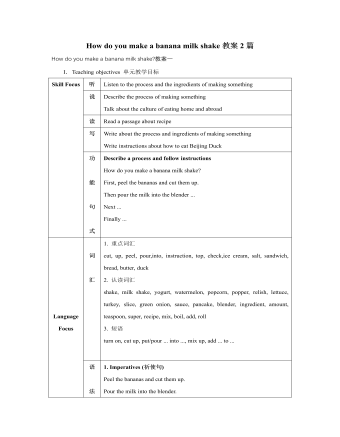
人教版新目标初中英语八年级上册How do you make a banana milk shake教案2篇
1. First, ... then, ... next, ... finally, ...首先,……然后,……接着,……最后,……这是英语中表达做某事的步骤的一种说法。如果步骤较多,还可以说:first-next-after that-later on-finally/at last通常你会听到说英语国家的人在说 first, next, then, finally 和后面的内容时,他们会做一些停顿。这样就能提前告诉听者接下来讲的是一系列的步骤。这一点在朗读和听力中应特别注意。2. how many, how much均为疑问词,同是“多少”,但用法不同。请看:how many修饰可数名词复数,how much修饰不可数名词。但在用法上,同学们常犯如下错误:1) [误] How many are there bananas on the table?[正] How many bananas are there on the table?[析] how many, how much 中的many,much是形容词,常修饰名词作定语,故后面跟名词。2) [误]How much tea are there on the table?[正]How much tea is there on the table?[析] how much修饰不可数名词时,谓语动词用单数。how many与how much的区别可简记为:前how many:问“多少”,复数名词后面跑;how much问“多少”,不可数名词单数好。前者答语用基数词,后者答语用数量关系。

人教版新目标初中英语八年级上册How was your school trip教案2篇
“Go for it!” is based on “Task-Based Language Teaching”. It adheres to “The authenticity principle”, “The form-function principle”, “The task dependency principle” and “The principle of learning by doing”. These principles all accord with the demands of curriculum focus.In and of Grade Seven (II), “Go for it!”, students have learned “The Simple Past Tense”. And it appears again in of Grade Eight (I). teaches students more about how to talk about events in the past. In addition, it gives affirmative and negative statements in the past tense, such as the sentence patterns “Did you see …?” “Were there …?” “Did you go …?” As the first part of Unit 8, Section A opens with a picture presenting the last school trip in the aquarium and continues with several step-by-step practice activities, which are all good for students to master “The Simple Past Tense”. Doing well in Section A will help students integrate the new target language with that in Section B. Thus, they can describe the events in the past freely and foster their own ability of reflecting and practicing. II. Teaching ObjectivesTeaching objective is the beginning and aim of teaching activities. According to the overall goal of the English elementary course--- improve students' synthetic ability of language application, which should be based on the development of students’ “Language knowledge”, “Language skills”, “Character building”, “Learning strategies” and “Cross-cultural awareness”. The teaching objectives are described as follows(I). Knowledge objectivesi. Master the simple past tense of regular and irregular verbsii. Recite the new words and expressions about the last school trip in the aquarium, including their pronunciation and intonation
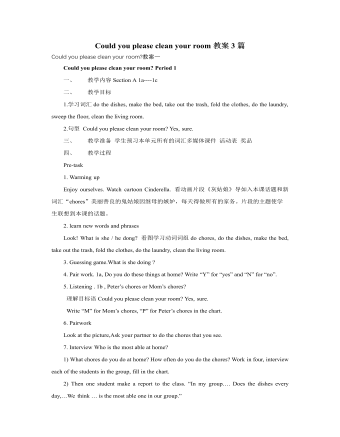
人教版新目标初中英语八年级上册Could you please clean your room教案3篇
一、 教学内容Section A 1a----1c二、 教学目标1.学习词汇do the dishes, make the bed, take out the trash, fold the clothes, do the laundry, sweep the floor, clean the living room.2.句型 Could you please clean your room? Yes, sure.三、 教学准备 学生预习本单元所有的词汇多媒体课件 活动表 奖品四、 教学过程Pre-task1. Warming upEnjoy ourselves. Watch cartoon Cinderella. 看动画片段《灰姑娘》导如入本课话题和新词汇“chores”美丽善良的鬼姑娘因继母的嫉妒,每天得做所有的家务。片段的主题使学生联想到本课的话题。2. learn new words and phrasesLook! What is she / he dong? 看图学习动词词组do chores, do the dishes, make the bed, take out the trash, fold the clothes, do the laundry, clean the living room.3. Guessing game.What is she doing ? 4. Pair work. 1a, Do you do these things at home? Write “Y” for “yes” and “N” for “no”.5. Listening . 1b , Peter’s chores or Mom’s chores?理解目标语Could you please clean your room? Yes, sure.Write “M” for Mom’s chores, “P” for Peter’s chores in the chart.6. PairworkLook at the picture,Ask your partner to do the chores that you see. 7. Interview Who is the most able at home? 1) What chores do you do at home? How often do you do the chores? Work in four, interview each of the students in the group, fill in the chart.

人教版新目标初中英语八年级上册How do you get to school教案2篇
Step Ⅶ Role play ( Work on 1b)1. First ask two students to read the dialogue to the class.Sa: How do you get to school?Sb: Well, I ride my bike to the subway station. Then I take the subway.2. Now work with a partner.Suppose you use two kinds of transportation to get to school \Hangzhou\Beijing... (bus, train, subway, walking, bike, etc.) Tell how you get there. You may use the phrases in 1a.3. Then ask different pairs of students to present their conversations to the class.Step ⅧListening1. Work on 2a(1) First ask students to read the list of information that Thomas wants to know.…where Nina lives.…how far from school she lives.…how long it takes to get to school.…how she gets to school.…what she thinks of the transportation.(2) Tell students what transportation and bus stop mean.bus stop 汽车站 transportation n. 运送;运输Then tell students we'll hear a recording. Please put a checkmark in front of each thing that Thomas wants to know.(3) Now play the recording for students.( Have students pay attention to the sample answer.) (4) Then correct the answers.
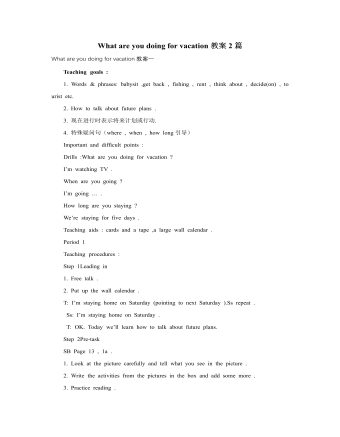
人教版新目标初中英语八年级上册What are you doing for vacation教案2篇
Teaching goals : 1. Words & phrases: babysit ,get back , fishing , rent , think about , decide(on) , tourist etc. 2. How to talk about future plans . 3. 现在进行时表示将来计划或行动. 4. 特殊疑问句(where , when , how long引导) Important and difficult points : Drills :What are you doing for vacation ? I’m watching TV . When are you going ? I’m going … . How long are you staying ? We’re staying for five days . Teaching aids : cards and a tape ,a large wall calendar . Period 1 Teaching procedures : Step 1Leading in1. Free talk . 2. Put up the wall calendar . T: I’m staying home on Saturday (pointing to next Saturday ).Ss repeat . Ss: I’m staying home on Saturday . T: OK. Today we’ll learn how to talk about future plans. Step 2Pre-task SB Page 13 , 1a . 1. Look at the picture carefully and tell what you see in the picture . 2. Write the activities from the pictures in the box and add some more . 3. Practice reading . Step 3While-task1. Using the activities we write in 1a to make conversations .For example :What are you doing for vacation ? I’m visiting my uncle . 2. Pairwork .Practice in pairs . 3. 用第三人称练习对话.

人教版新目标初中英语八年级上册I’m going to be a basketball player教案3篇
教学目标1.知识目标:(1)学习What are you going to be when you grow up?/How are you going to do that?句式。(2)学会用英语描述有关职业的表达法。2.能力目标:(1)能够谈论为实现理想所做出的打算和安排。(2)能够谈论未来自己与他人理想的职业及原因。(3)能用英语描述课余时间的活动安排,最终具备表达综合信息的能力。3.情感目标:新学期到来之际,让他们在学习、体育、饮食、特长、读书等方面制定计划,教育学生合理安排自己的课外生活,思考自己的理想职业及适合自己的职业。教学重点、难点本单元的重点为“be going to”表将来,want to be, what,where, when,how引导的特殊疑问句。难点是语言目标的实现。教材分析本单元以I am going to be a basketball player为话题,共设计了三部分的内容:一、Section A该部分有4个模块。第一模块围绕Do you think these jobs are interesting?这一话题展开思维(1a)、听力(1b)、口语(1c)训练;
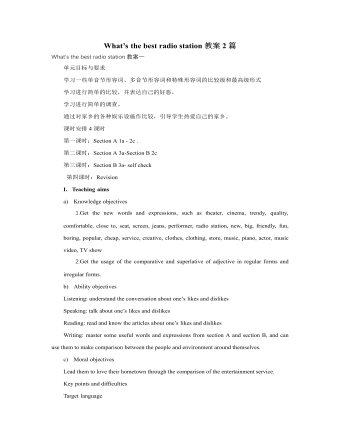
人教版新目标初中英语八年级上册What’s the best radio station教案2篇
教学重点和难点:运用所掌握的语言描述,比较不同地点的特点。在练习中学习掌握英语比较级和最高级的用法。课前准备分配小组,每组五至六人。通过上网或翻阅报刊杂志等方法,确定旅游线路,做出基本的旅游计划。教学设计:本节课流程图 学法指导:1.由于这是一堂新课,在教学中应注意面向全体,发挥学生的主体性,引导学生积极参与,激发学生的求知欲和学习积极性,指导学生积极思维,主动获取知识,养成良好的学习方法。逐步学会独立解决问题。总之要尽可能调动学生的非智力因素促进智力因素的发展。教法选择:1.电化教学法2.课堂讨论法3.任务型教学法采用这些方法的目的是为了充分调动学生的学习积极性,使学生变被动学习为主动学习。通过电脑形象的演示,加强印象,提高兴趣,突破难点,提高教学效率,进而增大教学的容量和信息量。充分体现教师为主导,学生为主体的教学原则。

人教版新目标初中英语八年级上册What’s the matter教案2篇
She shouldn’t go to the party tonight.Step7. TaskT: You know, there are lots of problems in our life. If you are a doctor, please tell us how to solve the problem. I will divide you into 9 groups. Please work in groups. And then choose one of you to report your ideas.The following are the problems:I have a toothache.I am hungry. I have a sore throat.I am stressed out. I have a sore back.I am tired. I can’t sleep.I have a cold. I have a headache.Report: If you have a headache, you should go to bed early. You should see the doctor. You should eat some medicine. You shouldn’t wash your face with cold water.You shouldn’t sleep late.You shouldn’t swim.…..T encourages the students to give advice as much as possible.Homework:1. Chose one of the problems, and write down your advice2. Copy the new words这一步是用于热身的,同时也可以让他们复习一部分的表示人体部位的单词,扩充知识.学习语言的过程也是一个不断积累的过程,复习旧知识,增添新知识.通过小游戏,强化学生对Does she/he have…这个句子的运用能力.通过复习,自然的引到下面新知识的学习。充分利用表格,由句子到对话,再到文章,让学生循序渐进. 提高学生的综合语言运用能力,运用以前学过的知识来解决身边的问题.Period 5 (Section B 3a—3c, selfcheck)教学内容与分析:
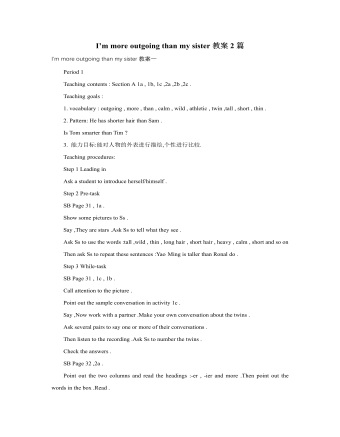
人教版新目标初中英语八年级上册I’m more outgoing than my sister教案2篇
1 交通工具的比较此活动为小组活动。学生通过讨论找出到达某一城市可乘坐的各种交通工具,并选择最佳出行方式。Teacher:We’re going to Shanghai. How many ways can we use to get there? Yes, there are four ways: by bus, by plane, by train, by ship. Please discuss how you are going to get there.操作建议:(1)学生以小组为单位展开活动,谈论本组所选择的交通工具。(2)各组选代表向全班汇报,阐述本组所选择的交通工具的利和弊。完成任务所需要的语言结构:We can go there by ship. It’s more comfortable and cheaper than any other transportation.We can go there by bus. It’s cheaper but it takes longer time.2 哪个城市更合适?此活动具有挑战性。假设中国要举行2014年世界杯足球赛,分别从历史,人文,天气等方面对各城市(北京,大连,上海,昆明)进行比较,选择最佳举办城市。T: Imagine China is holding the 2014 FIFA World Cup. Which city do you think is the best for the World Cup, Beijing, Dalian, Shanghai or Kunming? Let’s work in groups. If you choose Beijing, please join the Team Red. If you chose Dalian, please join the Team White. If you choose Shanghai, please join the Team Blue. If you choose Kunming, please join the Team Green. Please show us its advantages. Then let’s see which team will win.
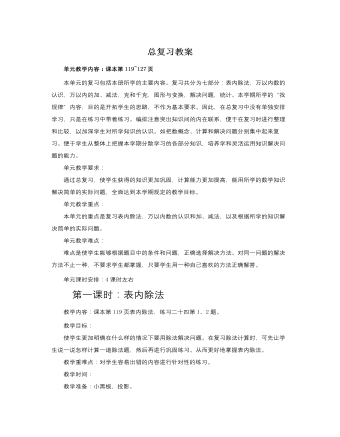
人教版新课标小学数学二年级下册总复习教案
教学时间:教学准备:小黑板,挂图。教学过程:一、复习旧知,引入新课。1、请大家想一想到今天为止,我们已经复习了本学期学过的哪些知识?(表内除法。万以内数的认识和加法、减法。克和千克及图形的变换。)2、对这些知识还有没有什么问题?还有没有内容是我们没有复习到或复习了掌握不好的?如果学生有问题,则针对问题,让同学们一起来想办法解决这些问题。学生提出问题,思考解决方法。二、复习整理:1、分别出示教材第122页第13、14题的挂图。(如果没有,就让学生直接看书)(1)看了图后,你明白图中的画是什么意思吗?学生看挂图,小组讨论这两题的意思。叙述两幅图的意思,没有说好的请其他同学来补充完整。在小组内讨论交流。(2)怎样来解决这两个生活中的实际问题?
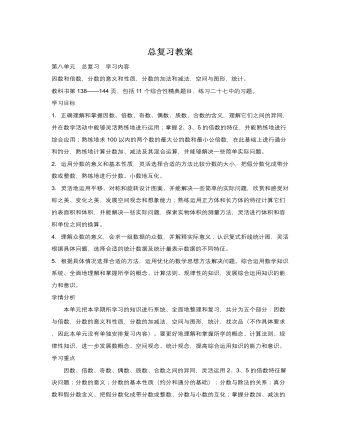
人教版新课标小学数学五年级下册总复习教案
此图是一个复式折线统计图,考察内容是根据统计图,进行数据的有效分析。(1)因为统计图中蓝色的折线表示学龄儿童,根据对学龄儿童的折线数据分析发现:1980年的学龄儿童最多,2000年的学龄儿童最少。(2)根据题目要求的分析:没上学的学龄儿童实际上是指:学龄儿童的人数与实际入学儿童人数的差。通过仔细观察统计图,可以直观地发现:1980年的学龄儿童和入学人数之间的差值最大,2000年的学龄儿童和入学人数之间的差值最小。所以,1980年没上学的学龄儿童最多,2000年的最少。(3)这一问比较开放,只要合理即可。三、练习二十七第9——14题解答指导:9. 81cm3=81ml 700dm3=0.7m3 560ml=0.56L 2.3dm3=2300cm310. 根据图示可知:把铁皮做成一个长方体,长方体的长为30—5×2=20(cm),宽为25—5×2=15(cm),高也就是切去的正方形的边长5cm。(1)求“这个盒子用了多少铁皮?”也就是求这个铁皮盒子(无盖)的表面积。
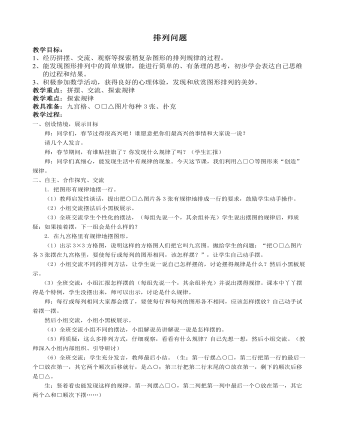
冀教版二年级数学下册排列问题教案
1.自学文本出示书中情境图:有21架飞机要参加飞行表演,怎样飞呢?想请同学们帮忙设计编组方案,下面小组同学合作,用学具摆一摆,设计出自己的编组方案,看哪个小组设计的方案最多?学生小组合作,边摆学具边说方案。2.交流研讨哪组想到前面来汇报一下你们制定的飞行方案?(不必强调平均分,如有小组同学说出每组有7(3)架,可以分成3(7)组,或每7(3)架一组,可以分成3(7)组,老师在给予肯定的同时可以问其它小组摆法一样吗?之后板书算式:21÷7=3,21÷3=7。如果学生没说出平均分,老师可引导说:有时表演的每组也可同样多)
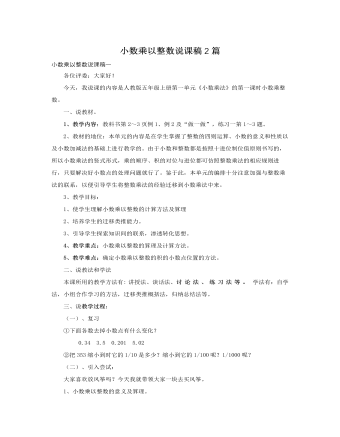
人教版新课标小学数学五年级上册小数乘以整数说课稿2篇
这样充分尊重学生的独立思考的过程与结果,鼓励学生想出多种方法计算,在学生汇报交流、反馈、评价中初步感受到转化的数学思想,获得成功的学习体验,之后教师评价:大家能把新的问题转化成已有的经验来解决,这种分析思考的方法很好,你们还能提出类似的问题吗?进而引入进一步的探索当中,教师作出这样的提示,这道题没有元角分,你们能把它也转化成已经学过的乘法算式吗?在学生独立思考计算的基础上,组织小组讨论,给每个学生展示自己思维的机会,教师深入小组收集信息,然后组织全班讨论,揭示算理,得出计算的方法。这一过程要重点突出算理的探索,使学生认识到小数乘法与整数乘法的联系,利用积变化的规律合理解释算理,通过学生亲身经历,主动参与,积极思考,自学交流等活动过程,使学生真正获得数学的知识和学习方法。
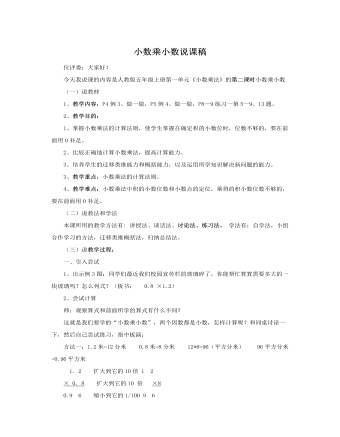
人教版新课标小学数学五年级上册小数乘小数说课稿
各位评委:大家好!今天我说课的内容是人教版五年级上册第一单元《小数乘法》的第二课时小数乘小数(一)说教材1、教学内容:P4例3、做一做,P5例4、做一做,P8—9练习一第5—9、13题。2、教学目的:1、掌握小数乘法的计算法则,使学生掌握在确定积的小数位时,位数不够的,要在前面用0补足。2、比较正确地计算小数乘法,提高计算能力。3、培养学生的迁移类推能力和概括能力,以及运用所学知识解决新问题的能力。3、教学重点:小数乘法的计算法则。4、教学难点:小数乘法中积的小数位数和小数点的定位,乘得的积小数位数不够的,要在前面用0补足。(二)说教法和学法本课所用的教学方法有: 讲授法、谈话法、讨论法、练习法。 学法有:自学法,小组合作学习的方法,迁移类推概括法,归纳总结法。
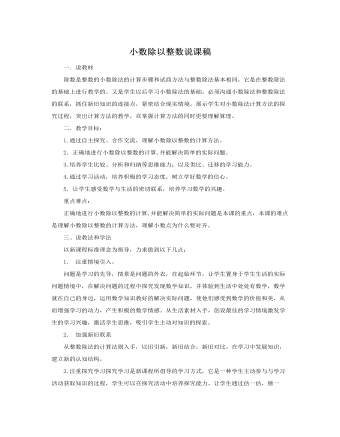
人教版新课标小学数学五年级上册小数除以整数说课稿
除数是整数的小数除法的计算步骤和试商方法与整数除法基本相同。它是在整数除法的基础上进行教学的。又是学生以后学习小数除法的基础,必须沟通小数除法和整数除法的联系,抓住新旧知识的连接点,紧密结合现实情境,展示学生对小数除法计算方法的探究过程,突出计算方法的教学,在掌握计算方法的同时更要理解算理。二.教学目标:1.通过自主探究、合作交流,理解小数除以整数的计算方法。2.正确地进行小数除以整数的计算,并能解决简单的实际问题。3.培养学生比较、分析和归纳等思维能力;以及类比、迁移的学习能力。4.通过学习活动,培养积极的学习态度,树立学好数学的信心。5.让学生感受数学与生活的密切联系,培养学习数学的兴趣。重点难点:正确地进行小数除以整数的计算,并能解决简单的实际问题是本课的重点,本课的难点是理解小数除以整数的计算方法,理解小数点为什么要对齐。
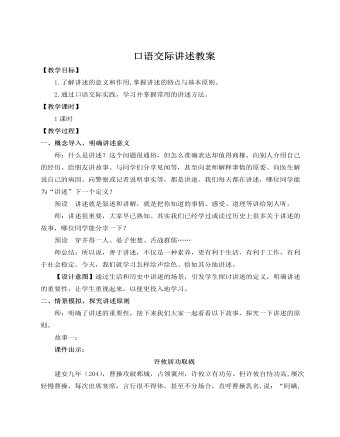
人教部编版语文八年级上册口语交际讲述教案
课件出示:(1)养成爱听、多听、会听的好习惯,比如多听新闻、听演讲、听别人说话等,从而形成语言智慧的丰富源泉。(2)多看电影、书报、电视访谈节目,还可以看现实生活中各种生动而感人的场景,为说积累素材。(3)多背诗词、格言、谚语等,能在情感上受到滋润、熏陶,慢慢形成自己正确而生动的语言。(4)多说才能使你的语言表达能力迅速提高。3.课后作业师:课后,各学习小组可以从课本P20“口语实践”六个话题中选择一两个,讲故事给你的同桌听。结束语:良言一句三冬暖,恶语伤人六月寒。讲述不仅仅是一门学问,更是一门艺术。讲述能力的提高仅仅通过一节课的学习是不够的,还希望同学们在日常的学习生活中多沟通,多交流。通过练习,你定能妙语连珠、侃侃而谈,舌灿莲花。
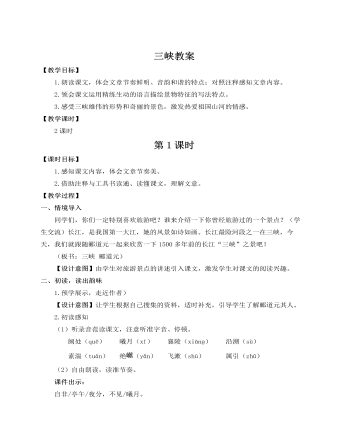
人教部编版语文八年级上册三峡教案
此外,多种形式的朗读,为学生在朗读中理解字词、内容、情感打下了基础。素养提升《三峡》中的修辞手法1.并提为了使句子紧凑、文笔简练,古人常用并提法行文,把本来应该写成两个短语或两个句子的话,合并为形式上的一个短语或一个句子,把相同的语句成分放在一起并提,但表意上仍然必须按照两个短语或句子的组合关系来分别相承,这种修辞手法就叫并提。这种句子翻译时应分为两句。如:(1)“自非亭午夜分,不见曦月。”“亭午”“夜分”是两个不并存的时间,“曦”和“月”是两种不同的自然现象,合起来是讲不通的,这句话应理解为“自非亭午,不见曦;自非夜分,不见月”(如果不是在正午,就看不到太阳;如果不是在半夜,就看不到月亮)。(2)“素湍绿潭,回清倒影。”这句和上句一样,应理解为“素湍回清,绿潭倒影”(白色的急流中有回旋的清波,绿色的潭水中有倒映着的各种景物的影子)。

人教部编版语文八年级上册消息二则教案
【活动二:学做播音员】用恰当的语调、语速、节奏播报这两则消息。师:如果你是播音员,要向全国人民播报这则振奋人心的消息,你会怎么播报?(任选一则)点拨:把握语调、语速、节奏等要素。新闻以陈述事实为主要内容,它不像散文、诗歌,有强烈的情感。新闻中很少用到叹号、问号等,所以播报的时候一般采用陈述语气。另外,要读出导语和主体之间的层次感,导语和主体之间停顿的时间可以稍长一点儿。像本课这样激动人心的消息,播报的时候声调可以高亢一些。【设计意图】此环节能让学生亲身体会新闻语言的特点,更深入地把握新闻内容,进一步感知新闻的特征。强烈的代入感也能让学生更直观、生动地内化学到的知识。三、学写新闻师:请大家把班里最近发生的新鲜事写成新闻,注意“六要素”“五部分”“三特点”,注意客观叙述,表达出自己的态度。
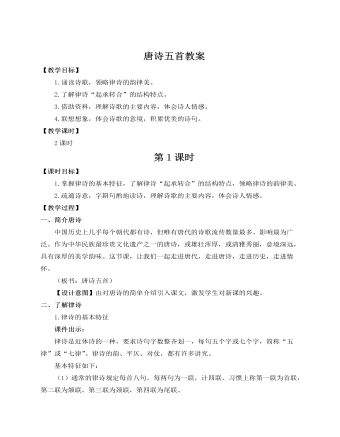
人教部编版语文八年级上册唐诗五首教案
(生交流讨论以下问题,师小结)设问1:本诗是围绕哪两个字来写的?诗人的行踪是怎样的?预设 围绕“春”“行”来写的。诗人行踪:孤山寺北—贾亭西—湖东—白沙堤。设问2:颔联中的“几处”“谁家”能不能换成“处处”“家家”,为什么?预设 不能。因为早莺尚少,只有“几处”;新燕不多,不知“谁家”。“几处”和“谁家”突出了初春事物都还很稀少。如果换成“处处”和“家家”,就体现不出早春的特点了。设问3:颔联中的“争”和“啄”两个动词用得好,请说说好在哪里。预设 这两个动词惟妙惟肖地描摹了莺燕的动态,传神地描绘了一幅充满生机的早春图,流露出诗人对如此美景的无限喜爱之情。设问4:尾联抒发了作者什么样的感情?预设 “最爱湖东行不足”,说明诗人流连忘返,陶醉在美好的湖光山色中了。体现了作者对早春西湖美景的喜爱和赞美之情。
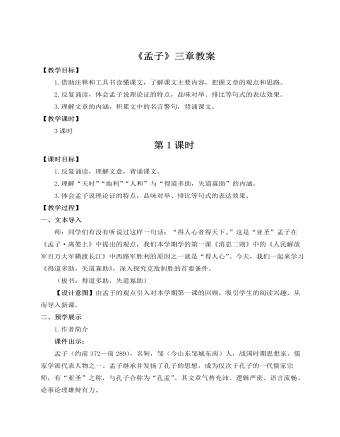
人教部编版语文八年级上册《孟子》三章教案
【设计意图】引导学生梳理文章内容,学习文章层层推理的特色。四、当堂检测《生于忧患,死于安乐》中提出担当大任的人必须经过艰苦的磨炼。请根据查找的相关资料,补充一些例子,并说说你的看法。1.司马迁受宫刑而作《史记》。2.曹雪芹举家食粥而写出了不朽的《红楼梦》。3.贝多芬即使在双耳失聪的情况下,仍然坚持音乐创作。(生交流讨论,举手发言)师小结:美国剧作家帕特里克说:“痛苦使人思索,思索使人明智,智慧使人生命持久。”优越的条件容易消磨人的意志,腐蚀人的健康肌体,使人丧失成功的上进心;而艰苦的环境,坎坷的道路,却能磨炼人的意志,增强人的上进心。学习了本文,希望大家悉心体会,思有所悟,学有所获。【设计意图】增强学生的忧患意识,激励学生要有克服困难的信心和勇气,学会正确对待生活中的困境。





















